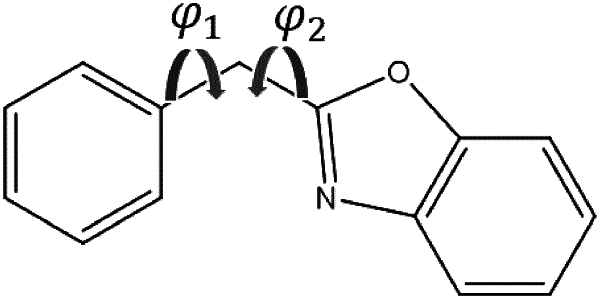| CPC G16C 20/20 (2019.02) [G16C 10/00 (2019.02)] | 20 Claims |

|
1. A potential energy surface scanning method for the analysis of molecular conformational space, implemented by a processor, comprising:
adjacent dihedral angle judgment: judge whether a given molecule has adjacent dihedral angles;
quantum mechanics (QM) coupling judgment: if it is judged that there are adjacent dihedral angles, judge whether the adjacent dihedral angles are coupled through QM calculation,
if the QM calculation judges that the adjacent dihedral angles are not coupled, perform an one-dimensional potential energy scan: restrain one dihedral angle from −180° to +180° at a set interval, relax the other dihedral angle, scan to obtain an one-dimensional potential energy surface of the molecule;
if the QM calculation judges that the adjacent dihedral angles are coupled, then perform a molecular mechanics (MM) coupling judgment: the MM calculation judges whether the adjacent dihedral angles are coupled;
if MM calculation judges that the adjacent dihedral angles are not coupled, then perform the one-dimensional potential energy surface scan: restrain one dihedral angle to change from −180° to +180° at a set interval and relax the other dihedral angle, scan to obtain the one-dimensional potential energy surface of the molecule;
if the MM calculation judges that the adjacent dihedral angles are coupled, then calculate a coverage of extreme points on a two-dimensional potential energy surface by a combination of the extreme points obtained by scanning individual one-dimensional potential energy surfaces of the two dihedral angles according to a MM scanning result, and determine a coverage level corresponding to the calculated coverage at least from a first level and a second level; wherein the coverage level corresponding to the calculated coverage is the first level if the calculated coverage is not smaller than a first preset value, the coverage level corresponding to the calculated coverage is the second level if the calculated coverage is smaller than a second preset value which is smaller than the first preset value;
if the coverage level corresponding to the calculated coverage is the first level, then perform the one-dimensional potential energy surface scan: restrain one dihedral angle to change from −180° to +180° at a set interval and relax the other dihedral angle, scan to obtain the one-dimensional potential energy surface of the molecule;
if the coverage level corresponding to the calculated coverage is not the first level, then perform a potential energy surface scan different from the one-dimensional potential energy surface scan.
|